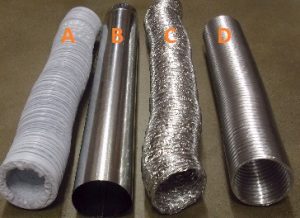Dryer Transition Duct Information

I have reviewed many home inspection reports and one of the many things that stand out is how some home inspectors report on dryer vent connectors. Recently a picture of a flexible dryer transition duct was posted on a home inspector Facebook page and another home inspector commented, “That’s not allowed”. Since his statement is not at all accurate, I’ve decided to take the time to write what is, and is not, allowed.
The different types of dryer vents
A. Plastic – Not UL listed for use as a dryer transition duct.
B. Smooth interior 28 gauge metal duct approved as a dryer duct
C. Foil flexible – UL approved as a dryer transition duct, but not recommended by the CPSC.
D. Semi-rigid – UL approved as a dryer transition duct and recommended by the CPSC
Definitions:
- Dryer Duct – This is the smooth wall section of the duct that runs through the house and passes through the exterior wall.
- Dryer Transition Duct – This is the flexible section that connects the dryer to the dryer duct.
Dryer Duct Rules: 2015 IRC M1502
M1502.2 Dryer Ducts need to be independent and convey moisture to the exterior.
M1502.3 Dryer ducts exhaust to the exterior, the discharge must have a backdraft damper and be at least 3 feet away from openings.
M1502.4.1 Dryer ducts are to be smooth and made out of metal that is a minimum 27-gauge steel. The dryer duct must be 4″ in diameter.
M1502.4.5.1 Dryer ducts shall be no more than 35 feet from outside terminal to transition duct. Exception: Unless the manufacturer of the dryer specifies differently. Most dryer manufacturers allow between 60 and 85 feet. Quite a big difference.
Transition Duct Rules: 2015 IRC M1502
M1502.4.2 Transition ducts shall be a single piece, listed as UL 2158A, not more than 8 feet long, and not concealed within construction.
Some dryer manufacturers and a bunch of home inspectors hate the foil dryer transition ducts. They are UL 2158A Listed for use with gas and electric dryers. Since Underwriters Laboratories does extensive testing and states that these transition ducts are acceptable for use in that fashion. I agree with UL and I don’t have a problem with them. Keep them clean and make sure they are not squished when installed.
Many inspectors like the semi-rigid aluminum ducts better. They state that the foil type gets clogged way too easy. Nobody has any data to back that up. There is Publication 5022 distributed June-2003 and updated Feb-2012 that addresses the dangers of dryer fires which mentions they shouldn’t be used. I do believe that the CPSC is a credible source, but I do not believe they did the same type of testing as is done by UL. Add this to my 36 years in the fire service, and I stand by my opinion that these foil type transition ducts are just fine.
For the record, the semi-rigid transition ducts can also be squished. They do not return to their original shape when the pressure is removed. There are also look-a-like semi-rigid ducts that are not UL listed.
I always believe that the choice of what is acceptable, and not acceptable, belongs to the home buyers. I believe my job is to give as much information as possible to help you make an educated decision.
Chicago Office Website: https://www.TheHomeInspectors.com/
Chicago Office Yelp Page: https://www.yelp.com/biz/chicagoland-home-inspectors-chicago
Northbrook Office Website: https://www.ChicagolandHomeInspectors.net
Northbrook Office Yelp: https://www.yelp.com/biz/chicagoland-home-inspectors-northbrook-2
YouTube: https://www.youtube.com/channel/UCWWsanAlMHMiAbez4OE1Gbg

Charles Bellefontaine CMI, CPI, ACI
May 21, 2018
Uncategorized
No Comment